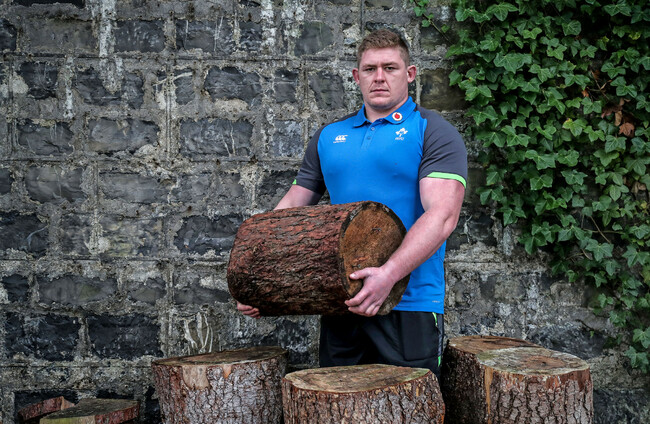LAST TIME IRELAND faced the Pumas, a 22-year-old Tadhg Furlong watched from the Millennium Stadium stands, wielding a camera, as his compatriots saw their World Cup dream obliterated.
He was in Joe Schmidt’s squad, all right, and had made an 18-minute cameo versus Romania in the pool stage, but while still a mere rookie in international rugby terms assumed the role of match-going tourist to much subsequent acclaim.
Only the Wexford prop wasn’t ‘vlogging’ what would transpire to be a gruesome experience at all, as he reveals a full two years, 15 Irish caps and three Lions appearances later.
“It wasn’t for personal use, that, to be fair,” he told the media at Carton House earlier today. “Yeah, it was for the scrum.
“So, d’you ever see on television, you only get to see one side of a scrum? So the TV cameras are mainly on one side of the pitch. We call it a scrum cam.
“Obviously, when you’re doing your analysis after a game and stuff, you only get to see one side of a scrum, and it’s only telling us a small fraction of what went on.
Usually, the spare front row is shafted with a camera in the stand. I wasn’t that great doing it at first. The first few times, the hand is very shaky.
And Furlong’s 10-minute deposition doesn’t stray too far from the scrum, in large part due to his conspicuous passion for it.
Argentina, with whom Furlong admits he has no major gripe considering he didn’t feature in 2015, scarcely get a look-in. Instead, he provides a scrummaging masterclass of sorts (verbally, of course), taking those present through his approach to an oft-misunderstood yet crucial aspect to his sport.
“I suppose everyone is different in a way. What I like to do is have a look at the opposition scrum, I suppose get my head around what’s coming. But then, a lot of the time in the scrum we have to focus on ourselves as well – like, our setup, how we connect with our second rows, how the hooker and the loosehead are working with you.
“A lot of that is in your control, and it doesn’t change much week to week.
You look at their scrum, and you see maybe where they’re trying to bring the force or angle, or where they like to attack – to go forward. And then you put emphasis on specific joint shoulders within the [your own] scrum.
“Also, with your bind, you’d be looking at the loosehead: some looseheads lift up, some loosheads lean forward. It all changes on where you bind, and how you can – I suppose – get yourself in the scrum the way you’d like to.
“But it’s all in theory. I suppose you learn as you go, so you look at it in theory: ‘this should work. In the past, this is what worked.’ And then it’s putting it out on the field and trying to execute it is the tough part.
“I enjoy looking at scrums – what other teams are doing; how other second rows and back fives are scrummaging; what works well, what doesn’t work well; what can we rob off them?
“It’s all about trying to execute it at the weekend, then.”
But even allowing for the countless hours spent analysing the minutiae of the opposition’s binds and pressure points, many games will still present Furlong – still just 25 – with their own scrummaging surprises.
Much of it comes down to short-term memory in the heat of the moment, he explains, and attempting to get a feel for opponents’ intentions over the course of a game.
“When you’re looking at a scrum, you see what’s happening,” Furlong said.
“But when you’re in there, you can’t look from the outside – d’you know what I mean?
It’s all about your feeling, there: you remember the feeling you had in the [last] scrum, where the pressure was coming from, and what you did to counteract it.
“It’s one thing looking at it, it’s another thing to feel it, and trying to problem-solve with the feeling when you can’t look at the tape to see what you look like, if you know what I mean.”
Video analysis, then, isn’t entirely foolproof, but the Campile front row admits it’s difficult to pull a fast one and improvise in the heat of battle.
“I wouldn’t say it’s all that easy to do, to be honest with you, because it’s so repetitive.
“If I change something in my setup – just say I change where one of my legs stand, or if I’m pulling one way or the other – it has a knock-on effect between the second row behind me and my hooker and loosehead on the far side of me.
“So, in theory it might sound a clever thing to do, but I suppose you’re after doing so many reps doing it one way, the smallest change can have an effect on everyone around you.
“It’s those little bits that just throw you off is what, at this level of scrummaging, skews execution for you.”
“He’s got to the point where he’s managed to turn the camera on now, he missed a few couple of minutes in that game!” laughed Ireland assistant coach Greg Feek, who addressed the media following Scrummaging 101 with Mr. Furlong.
“In terms of that he’s come a long way.”
Feek does, however, proceed to wax lyrical about the Leinsterman in a more sincere sense, lauding his progress from spare prop to star prop in the space of just two years.
“You guys know his progression, and he’s a guy that’s just got so much energy. He can run all day, talk all day, and that’s one thing that’s contagious when he’s in there.
He loves seeing his team-mates do something really well – one of the first to go over to say well done. He thinks deeply too about the game – he’s very astute in that respect, and he wants to get things right on the pitch.
“And he’s still got the hunger to learn,” Feek added.
“He knows that the last couple of years have been massive and you want that to keep building.
“All the good players, top players we work with – they always feel a little uncomfortable if they go well, and he’s no different.
“Just the excitement he has to keep being able to do more, learn, ask for feedback.
The really top players are not afraid to get a bit of feedback if they think it will help them get better. Some players can get a bit defensive, but Tadhg would just soak it up. A lot of that comes down to character of the person, you see that in where he’s from, and you’re willing to take a gamble with someone like that.
The42 has just published its first book, Behind The Lines, a collection of some of the year’s best sports stories. Pick up your copy in Eason’s, or order it here today (€10):












This will cost the GAA a lot as referees wont have the power to play for a draw at the end of the game.
Long overdue in fairness it’s worked great in the ladies game. The supporter’s will love it too, will really get involved in last 10mins. Players will feel the pressure of it too its great I can’t wait. Bring on the summer gaa.
There might be very little action in the last minutes. If a team is up by one or two points they’ll just run the clock down by bringing on the rest of their subs. The clock won’t stop for subs. This is madness.
The clock never stops and time is never added on for subs in any case. Substitutions are considered within the time parameters of the game. The clock will stop for injuries and necessary breaks in play. It’s not mad at all. It’s very simple.
A no no no no! If it not broken don’t fix it!
What a stupid idea
When will they vote to god rid of putting your foot under ball and to chop the b*ll*x of all male players? Bunch of gombeens up there in Croke park